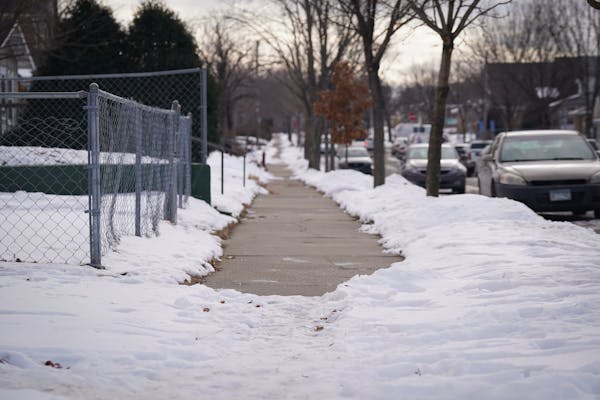Minnesota has struggled to kick the habit of over-salting winter sidewalks and roads.
Yes, the ice is dangerous for drivers and pedestrians — but so is the chloride in the runoff that poisons Minnesota's lakes, streams and rivers, particularly in the Twin Cities. State agencies such as the Department of Transportation and many cities and other public entities have gotten the message and are finding ways to cut salt use, water resource professionals working on the problem say.
But most property managers and snow removal companies have not.
"We're not seeing that same shift on the private side," said Jessica Wilson, water resources manager for the city of Edina.
Wilson is seeking to change that. She's part of the Hennepin County Chloride Initiative launching a "Low Salt, No Salt" campaign this week to put a lid on the buckets of ice-melt to protect the water. It's not another public awareness campaign, but free and hands-on technical assistance for property owners and private salt applicators.
The group is a coalition of 11 cities and watershed districts whose members say they understand the pressure on property owners to avoid hazardous ice. They fear being sued for falls. It's deeply ingrained that people need to crunch across blue crystals in winter for safety — and people feel vulnerable otherwise, said Laura Jester, administrator of the Bassett Creek Watershed Management Commission, who helped develop the new program.
Bassett Creek is one of scores of waterways — including the Mississippi, Minnesota and St. Croix rivers — with increasing levels of chloride pollution, according to the Metropolitan Council, which has been tracking it. A mere 10% of waterbodies in the seven-county metro area have been sampled for chloride, but that shows 42 lakes, ponds, rivers and streams contaminated with excess chloride, according to the council.
The saltier water damages the ecosystems for fish, invertebrates and insects.
The initial targets of the "Low Salt, No Salt" campaign are the boards of homeowners associations, condos and townhouses; and churches, synagogues and other faith-based communities.
"We feel like those folks have a really vested interested in how the property is managed, where they live or pray," Jester said.
The initial rollout is mostly in Hennepin County, but no one is excluded. The Capitol Region Watershed District in St. Paul is already enlisting three faith-based groups to reduce salt on private property. The plan is to expand the program to small businesses and neighborhood associations.
Trained members will soon be contacting property owners by mail or telephone to meet with them and lend a hand.
They'll come with a range of tools to share beyond a new website. They include model contracts for hiring snow and ice removal companies, advice on communicating risk, grant-writing help and guidance on finding the best type of "smart salting" training the Minnesota Pollution Control Agency offers.
"It's very hands-on," said Edina's Wilson. "This program is meant to establish a relationship with a trusted professional."
At the Legislature, a group of lawmakers is trying again this year to pass a measure to protect property owners and commercial applicators from being sued for ice hazards and slip-and-falls if they can show they took the state's smart salting training and used best practices. The bills are HF820 and SF755.
Brooke Asleson, who runs the MPCA's chloride reduction program, said she wants "Low Salt, No Salt" to go statewide.
"I think it is going to be our next pathway forward," said Asleson. The majority of the estimated 6,000 people certified through the MPCA's salt training since 2017 work in the public sector, she said. More training on the private side is critical to cutting chloride pollution.
It's particularly challenging because salt is an effective, cheap ice treatment.
Most de-icers use some form of chloride, including the salt MnDOT uses on roads. So do the bags and pails of ice-melt people buy in the store, even when they're labeled "pet friendly," "green" or "eco friendly." The active ingredients are typically calcium chloride, magnesium chloride or sodium chloride, or a mix.
The de-icing salt is the top source of the chloride polluting the Twin Cities' lakes, rivers and streams. There is no cost-effective way to remove it, and it doesn't dissolve on its own; the chloride just accumulates. You can't see it, but the water gets saltier and runs into the Mississippi River and down to the Gulf of Mexico.
Chloride levels in metro area waterbodies continue to rise, though more gradually in recent years, said Emily Resseger, a water resources environmental analyst at the Met Council. She said they hope to see the chloride levels decrease in five years.
Minnesota now has a statewide chloride management plan. Unfortunately, no large-scale non-chloride alternative has emerged to replace road salt. Potassium acetate showed promise but turned out to be highly toxic too, Asleson said. Sand is always a good option. There are chloride-free products on the market such as Traction Magic that homeowners can use.
Wilson said that even after a decade of awareness-building about chloride, people are still surprised to learn that one teaspoon of road salt is enough to permanently pollute 5 gallons of water. They're also shocked to learn that applying more salt does not increase its effectiveness on ice.
Changing the salt habit is hard, she said. "It's definitely a culture thing."

Want to share info with the Star Tribune? How to do it securely

'Safe recovery sites' would offer syringes, naloxone and more to people using drugs. The plan could be in peril.
New Minnesota GOP leaders seek peace with party's anti-establishment wing

Who is Republican Lisa Demuth, Minnesota's first House speaker of color?

